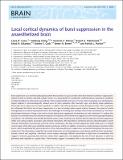| dc.contributor.author | Peterfreund, R. A. | |
| dc.contributor.author | Eskandar, Emad | |
| dc.contributor.author | Cash, Sydney S. | |
| dc.contributor.author | Purdon, P. L. | |
| dc.contributor.author | Lewis, Laura D. | |
| dc.contributor.author | Ching, Shinung | |
| dc.contributor.author | Weiner, Veronica S. | |
| dc.contributor.author | Brown, Emery Neal | |
| dc.date.accessioned | 2013-12-02T17:08:17Z | |
| dc.date.available | 2013-12-02T17:08:17Z | |
| dc.date.issued | 2013-07 | |
| dc.date.submitted | 2013-05 | |
| dc.identifier.issn | 0006-8950 | |
| dc.identifier.issn | 1460-2156 | |
| dc.identifier.uri | http://hdl.handle.net/1721.1/82617 | |
| dc.description.abstract | Burst suppression is an electroencephalogram pattern that consists of a quasi-periodic alternation between isoelectric ‘suppressions’ lasting seconds or minutes, and high-voltage ‘bursts’. It is characteristic of a profoundly inactivated brain, occurring in conditions including hypothermia, deep general anaesthesia, infant encephalopathy and coma. It is also used in neurology as an electrophysiological endpoint in pharmacologically induced coma for brain protection after traumatic injury and during status epilepticus. Classically, burst suppression has been regarded as a ‘global’ state with synchronous activity throughout cortex. This assumption has influenced the clinical use of burst suppression as a way to broadly reduce neural activity. However, the extent of spatial homogeneity has not been fully explored due to the challenges in recording from multiple cortical sites simultaneously. The neurophysiological dynamics of large-scale cortical circuits during burst suppression are therefore not well understood. To address this question, we recorded intracranial electrocorticograms from patients who entered burst suppression while receiving propofol general anaesthesia. The electrodes were broadly distributed across cortex, enabling us to examine both the dynamics of burst suppression within local cortical regions and larger-scale network interactions. We found that in contrast to previous characterizations, bursts could be substantially asynchronous across the cortex. Furthermore, the state of burst suppression itself could occur in a limited cortical region while other areas exhibited ongoing continuous activity. In addition, we found a complex temporal structure within bursts, which recapitulated the spectral dynamics of the state preceding burst suppression, and evolved throughout the course of a single burst. Our observations imply that local cortical dynamics are not homogeneous, even during significant brain inactivation. Instead, cortical and, implicitly, subcortical circuits express seemingly different sensitivities to high doses of anaesthetics that suggest a hierarchy governing how the brain enters burst suppression, and emphasize the role of local dynamics in what has previously been regarded as a global state. These findings suggest a conceptual shift in how neurologists could assess the brain function of patients undergoing burst suppression. First, analysing spatial variation in burst suppression could provide insight into the circuit dysfunction underlying a given pathology, and could improve monitoring of medically-induced coma. Second, analysing the temporal dynamics within a burst could help assess the underlying brain state. This approach could be explored as a prognostic tool for recovery from coma, and for guiding treatment of status epilepticus. Overall, these results suggest new research directions and methods that could improve patient monitoring in clinical practice. | en_US |
| dc.description.sponsorship | Burroughs Wellcome Fund (Career Award at the Scientific Interface) | en_US |
| dc.description.sponsorship | National Institutes of Health (U.S.) (Director's Pioneer Award DP10D003646) | en_US |
| dc.description.sponsorship | National Institutes of Health (U.S.) (Transformative 1R01GM104948) | en_US |
| dc.language.iso | en_US | |
| dc.publisher | Oxford University Press | en_US |
| dc.relation.isversionof | http://dx.doi.org/10.1093/brain/awt174 | en_US |
| dc.rights.uri | http://creativecommons.org/licenses/by-nc/3.0/ | en_US |
| dc.source | PMC | en_US |
| dc.title | Local cortical dynamics of burst suppression in the anaesthetized brain | en_US |
| dc.type | Article | en_US |
| dc.identifier.citation | Lewis, L. D., S. Ching, V. S. Weiner, R. A. Peterfreund, E. N. Eskandar, S. S. Cash, E. N. Brown, and P. L. Purdon. “Local cortical dynamics of burst suppression in the anaesthetized brain.” Brain 136, no. 9 (August 27, 2013): 2727-2737. | en_US |
| dc.contributor.department | Massachusetts Institute of Technology. Institute for Medical Engineering & Science | en_US |
| dc.contributor.department | Harvard University--MIT Division of Health Sciences and Technology | en_US |
| dc.contributor.department | Massachusetts Institute of Technology. Department of Brain and Cognitive Sciences | en_US |
| dc.contributor.mitauthor | Lewis, Laura D. | en_US |
| dc.contributor.mitauthor | Ching, Shinung | en_US |
| dc.contributor.mitauthor | Weiner, Veronica S. | en_US |
| dc.contributor.mitauthor | Brown, Emery N. | en_US |
| dc.relation.journal | Brain | en_US |
| dc.eprint.version | Final published version | en_US |
| dc.type.uri | http://purl.org/eprint/type/JournalArticle | en_US |
| eprint.status | http://purl.org/eprint/status/PeerReviewed | en_US |
| dspace.orderedauthors | Lewis, L. D.; Ching, S.; Weiner, V. S.; Peterfreund, R. A.; Eskandar, E. N.; Cash, S. S.; Brown, E. N.; Purdon, P. L. | en_US |
| dc.identifier.orcid | https://orcid.org/0000-0001-6888-5448 | |
| dc.identifier.orcid | https://orcid.org/0000-0003-2668-7819 | |
| mit.license | PUBLISHER_CC | en_US |
| mit.metadata.status | Complete | |
